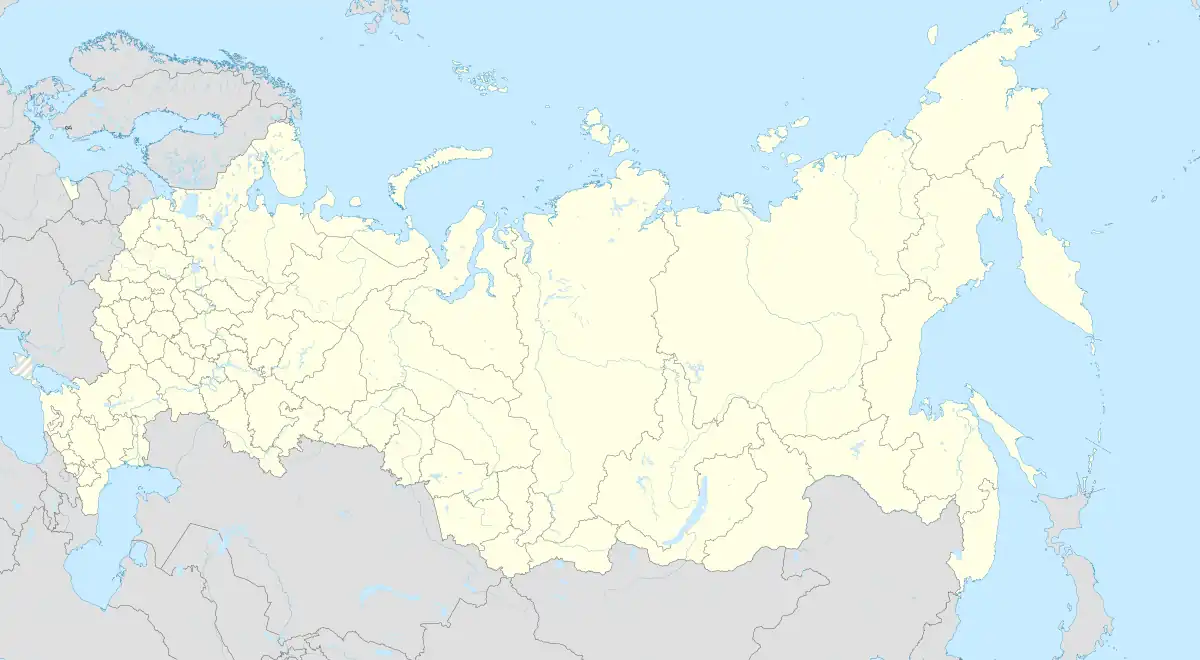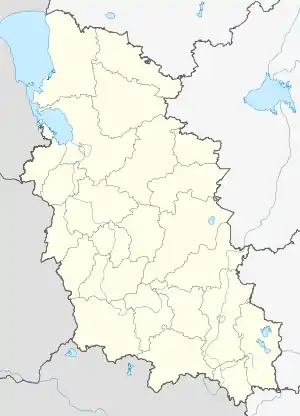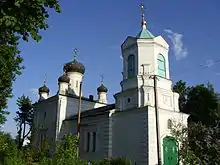Nevel (town)
Nevel (Russian: Не́вель) is a town and the administrative center of Nevelsky District in Pskov Oblast, Russia, located on Lake Nevel 242 kilometers (150 mi) southeast of Pskov, the administrative center of the oblast. Population: 16,324 (2010 Census);[3] 18,545 (2002 Census);[10] 22,472 (1989 Census).[11]
Nevel
Невель | |
|---|---|
 | |
.png.webp) Flag .png.webp) Coat of arms | |
Location of Nevel | |
 Nevel Location of Nevel  Nevel Nevel (Pskov Oblast) | |
| Coordinates: 56°02′N 29°55′E | |
| Country | Russia |
| Federal subject | Pskov Oblast[1] |
| Administrative district | Nevelsky District[1] |
| Founded | 1504 (Julian) |
| Town status since | 1772[2] |
| Elevation | 155 m (509 ft) |
| Population | |
| • Total | 16,324 |
| • Estimate (2018)[4] | 15,079 (−7.6%) |
| • Capital of | Nevelsky District[5] |
| • Municipal district | Nevelsky Municipal District[6] |
| • Urban settlement | Nevel Urban Settlement[6] |
| • Capital of | Nevelsky Municipal District,[7] Nevel Urban Settlement[6] |
| Time zone | UTC+3 (MSK |
| Postal code(s)[9] | 182500, 182503, 182549 |
| Dialing code(s) | +7 81151 |
| OKTMO ID | 58620101001 |
History
Lithuania (
PLC) 1580–1582
Tsardom of Russia 1582–1617
Lithuania (
PLC) 1617–1655
Tsardom of Russia 1655–1678
Lithuania (
PLC) 1678–1772
Russian Empire 1772–1917
Russian Republic 1917
Soviet Belarus 1919
Soviet Russia 1919–1922
Soviet Union 1922–1991
German occupation July 1941–October 1943
Russian Federation 1991–present
Nevel was first mentioned in Ivan the Terrible's will among towns that had been founded during his reign.[2] Between 1580 and 1772, it frequently changed ownership.[2]
In 1623, it was granted Magdeburg rights by the Polish–Lithuanian King Władysław IV Vasa. While part of the Polish–Lithuanian Commonwealth it was located in the Polotsk Voivodeship of the Grand Duchy of Lithuania.
Nevel became part of Russia during the First Partition of Poland in 1772,[12] when it was included into newly established Pskov Governorate, chartered,[2] and made the seat of Nevesky Uyezd of Pskov Governorate. In 1777, it was transferred to Polotsk Viceroyalty. In 1796, the viceroyalty was abolished and Nevel was transferred to the Belarusian Governorate; it formed a part of Vitebsk Governorate from 1802.[2]
.jpg.webp)
20th century
In early 1919 it was part of the Socialist Soviet Republic of Byelorussia. After 1919, Vitebsk Governorate was a part of the Russian Soviet Federative Socialist Republic.[13] On March 24, 1924, Vitebsk Governorate was abolished, and Nevel was transferred to Pskov Governorate.[2]
On August 1, 1927, the uyezds and governorates were abolished and Nevelsky District, with the administrative center in Nevel, was established as a part of Velikiye Luki Okrug of Leningrad Oblast.[14] It included parts of former Nevelsky Uyezd.[15] On June 3, 1929, Nevelsky District was transferred to Western Oblast.[15] On July 23, 1930, the okrugs were also abolished and the districts were directly subordinated to the oblast.[14] On January 29, 1935, Western Oblast was abolished and the district was transferred to Kalinin Oblast, and on February 5 of the same year, Nevelsky District became a part of Velikiye Luki Okrug of Kalinin Oblast,[14] one of the okrugs abutting the state boundaries of the Soviet Union. On May 4, 1938, the district was subordinated directly to the oblast.[14] During World War II, Nevel was under German occupation from 16 July 1941 until 6 October 1943.[16] On August 22, 1944, the district was transferred to newly established Velikiye Luki Oblast.[14] On October 2, 1957, Velikiye Luki Oblast was abolished and Nevelsky District was transferred to Pskov Oblast.[14]
Administrative and municipal status
Within the framework of administrative divisions, Nevel serves as the administrative center of Nevelsky District,[5] to which it is directly subordinated.[1] As a municipal division, the town of Nevel is incorporated within Nevelsky Municipal District as Nevel Urban Settlement.[6]
Economy
Industry
Nevel has enterprises of food, textile, shoemaking, and timber industries.[17]
Transportation
.jpg.webp)
Nevel is connected at the crossing of two railway lines. One connects Velikiye Luki with Polotsk (Nevel-1 railway station), whereas another one connects St. Petersburg via Dno and Novosokolniki with Vitebsk (Nevel-2 railway station). South of Nevel, both railways cross into Belarus.
There M20 Highway connecting St. Petersburg and Kyiv passes next to Nevel. Other main roads connect Nevel with Velikiye Luki, with Smolensk via Usvyaty and Velizh, with Polotsk, and with Verkhnyadzvinsk via Rossony. There are also local roads.
Culture

Nevel contains three objects classified as cultural and historical heritage of local significance.[18] The monuments are the Trinity Church (built in the 1850s), the building of the uyezd school, and the military cemetery from World War II.
Nevel is home to the Nevel Museum of History, featuring the history of the town.[19]
Notable people
- Mikhail Bakhtin (1895-1975) — Russian philosopher, literary critic and semiotician
- Maria Yudina (1899-1970) — Soviet pianist
- Reb Zalman Moishe (1872—1952) — Orthodox Jewish Chabad-Lubavitch Rabbi in pre-war Europe
- Yevgeny Dyakonov (1935-2006) — Russian mathematician
- Filipp Goloshchyokin (1876-1941) — Soviet politician and revolutionary
- Manshuk Mametova (1922-1943) — Soviet Kazakh machine gunner, first Soviet Asian woman to receive the Hero of the Soviet Union medal
- Aaron Rubashkin (1927/28–2020) — Jewish-American businessman
- Grigori Voitinsky (1893-1953) — Soviet politician
- Morris S. Novik (1903–1996) — American socialist politician and radio manager
- Dov Schwartzman (1921–2011) — Haredi Jewish rabbi and dean of Bais Hatalmud (Jerusalem)
- Valentin Voloshinov (1895-1936) — Russian philosopher and linguist
- Konstantin Zaslonov (1910-1942) — Soviet partisan kommander, Hero of the Soviet Union
References
Notes
- Law #833-oz stipulates that the borders of the administrative districts are identical to the borders of the municipal districts. The Law #420-oz, which describes the borders and the composition of the municipal districts, lists the town of Nevel as a part of Nevelsky District.
- Энциклопедия Города России. Moscow: Большая Российская Энциклопедия. 2003. p. 293. ISBN 5-7107-7399-9.
- Russian Federal State Statistics Service (2011). Всероссийская перепись населения 2010 года. Том 1 [2010 All-Russian Population Census, vol. 1]. Всероссийская перепись населения 2010 года [2010 All-Russia Population Census] (in Russian). Federal State Statistics Service.
- "26. Численность постоянного населения Российской Федерации по муниципальным образованиям на 1 января 2018 года". Federal State Statistics Service. Retrieved January 23, 2019.
- Государственный комитет Российской Федерации по статистике. Комитет Российской Федерации по стандартизации, метрологии и сертификации. №ОК 019-95 1 января 1997 г. «Общероссийский классификатор объектов административно-территориального деления. Код 58 220», в ред. изменения №278/2015 от 1 января 2016 г.. (State Statistics Committee of the Russian Federation. Committee of the Russian Federation on Standardization, Metrology, and Certification. #OK 019-95 January 1, 1997 Russian Classification of Objects of Administrative Division (OKATO). Code 58 220, as amended by the Amendment #278/2015 of January 1, 2016. ).
- Law #420-oz
- Федеральная служба государственной статистики. Федеральное агентство по технологическому регулированию и метрологии. №ОК 033-2013 1 января 2014 г. «Общероссийский классификатор территорий муниципальных образований. Код 58 620». (Federal State Statistics Service. Federal Agency on Technological Regulation and Metrology. #OK 033-2013 January 1, 2014 Russian Classification of Territories of Municipal Formations. Code 58 620. ).
- "Об исчислении времени". Официальный интернет-портал правовой информации (in Russian). June 3, 2011. Retrieved January 19, 2019.
- Почта России. Информационно-вычислительный центр ОАСУ РПО. (Russian Post). Поиск объектов почтовой связи (Postal Objects Search) (in Russian)
- Russian Federal State Statistics Service (May 21, 2004). Численность населения России, субъектов Российской Федерации в составе федеральных округов, районов, городских поселений, сельских населённых пунктов – районных центров и сельских населённых пунктов с населением 3 тысячи и более человек [Population of Russia, Its Federal Districts, Federal Subjects, Districts, Urban Localities, Rural Localities—Administrative Centers, and Rural Localities with Population of Over 3,000] (XLS). Всероссийская перепись населения 2002 года [All-Russia Population Census of 2002] (in Russian).
- Всесоюзная перепись населения 1989 г. Численность наличного населения союзных и автономных республик, автономных областей и округов, краёв, областей, районов, городских поселений и сёл-райцентров [All Union Population Census of 1989: Present Population of Union and Autonomous Republics, Autonomous Oblasts and Okrugs, Krais, Oblasts, Districts, Urban Settlements, and Villages Serving as District Administrative Centers]. Всесоюзная перепись населения 1989 года [All-Union Population Census of 1989] (in Russian). Институт демографии Национального исследовательского университета: Высшая школа экономики [Institute of Demography at the National Research University: Higher School of Economics]. 1989 – via Demoscope Weekly.
- История района (in Russian). Портал муниципальных образований Псковской области. Retrieved June 23, 2014.
- Область (местность) (in Russian). Great Soviet Encyclopedia. Archived from the original on March 31, 2014. Retrieved June 23, 2014.
- Administrative-Territorial Structure of Pskov Oblast, pp. 11–14
- Невельский район (август 1927 г. - июнь 1929 г.) (in Russian). Справочник истории административно-территориального деления Ленинградской области. Archived from the original on November 3, 2013. Retrieved June 23, 2014.
- Освобождение городов
- Промышленность (in Russian). Портал муниципальных образований Псковской области. Retrieved October 3, 2012.
- Памятники истории и культуры народов Российской Федерации (in Russian). Russian Ministry of Culture. Retrieved June 2, 2016.
- Музей истории г. Невеля (in Russian). Российская сеть культурного наследия. Retrieved October 5, 2012.
Sources
- Псковское областное Собрание депутатов. Закон №833-оз от 5 февраля 2009 г. «Об административно-территориальном устройстве Псковской области». Вступил в силу со дня официального опубликования. Опубликован: "Псковская правда", №20, 10 февраля 2009 г. (Pskov Oblast Council of Deputies. Law #833-oz of February 5, 2009 On the Administrative-Territorial Structure of Pskov Oblast. Effective as of the official publication date.).
- Псковское областное Собрание депутатов. Закон №420-оз от 28 февраля 2005 г. «Об установлении границ и статусе вновь образуемых муниципальных образований на территории Псковской области», в ред. Закона №1542-ОЗ от 5 июня 2015 г. «О внесении изменений в Закон Псковской области "Об установлении границ и статусе вновь образуемых муниципальных образований на территории Псковской области"». Вступил в силу со дня официального опубликования. Опубликован: "Псковская правда", №41–43, №44–46, №49–51, 4 марта 2005 г., 5 марта 2005 г., 11 марта 2005 г. (Pskov Oblast Council of Deputies. Law #420-oz of February 28, 2005 On Establishing the Borders and the Status of the Newly Formed Municipal Formations on the Territory of Pskov Oblast, as amended by the Law #1542-OZ of June 5, 2015 On Amending the Law of Pskov Oblast "On Establishing the Borders and the Status of the Newly Formed Municipal Formations on the Territory of Pskov Oblast". Effective as of the official publication date.).
- Архивный отдел Псковского облисполкома. Государственный архив Псковской области. "Административно-территориальное деление Псковской области (1917–1988 гг.). Справочник". (Administrative-Territorial Structure of Pskov Oblast (1917–1988). Reference.) Книга I. Лениздат, 1988
External links
- The murder of the Jews of Nevel during World War II, at Yad Vashem website.